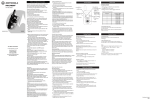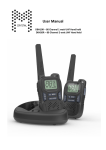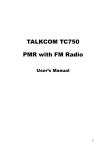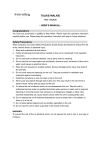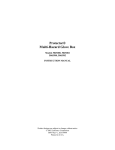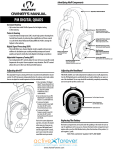Download User Manual - Retevis.com
Transcript
Walkie-Talkie Getting Started Installing the AA Batteries Your radio uses 3 AA Alkaline batteries. 1. With the back of the radio facing you, lift the battery latch up to release the battery cover and remove. User Manual and Instruction 2. Insert 3 AA Alkaline batteries as shown on the inside of the battery compartment. 3. Reposition the battery cover and press down to secure. The Walkie-Talkie can use a NiMH rechargeable battery instead of 3 AA Alkaline batteries. Battery Meter The battery icon shows the battery charge level, from full to empty .When the battery is empty, the radio chirps periodically after releasing . The radio powers off when the voltage drops below a predetermined level to protect the rechargeable battery. Note: Remove the batteries before storing your radio for extended periods of time. Batteries corrode over time and may cause permanent damage to your radio. Turning Your Radio On and Off After you insert batteries turn the radio on, the radio chirps and the display briefly shows all feature icons available on your radio. The display then scrolls through the available channels and Interference Eliminator Codes. Press and hold button turn the radio off. Setting the Volume Page 1 - Press the up button to increase the speaker volume. Press the down button to decrease the speaker volume. The speaker volume level is indicated by the numbers 1-16 displayed. • Lock and unlock the keypad (when held down and not in a menu) Use to: • Talk • Save a setting Get Setting a Channel 1. With the radio on, press Talking and Listening , The current channel flashes. 2. Press up or down to set the channel. To communicate, all radios in your group must be set to the same channel 3. Press PTT to save the channel setting. and Interference Eliminator Code. Getting Started To talk, press and hold PTT. Hold the radio 2 to 3 inches away from your mouth when speaking. When you finish speaking, release PTT (press to talk, release to listen). Control Buttons Use • Scan / Checking the Channel Before Transmitting to: Your radio has multiple channels shared on a “take turn” basis. For • Turn radio on/off uninterrupted communication, do not talk on a channel if someone else is currently talking on it. Use UP/DOWN to: To check for activity on a channel before you talk, press and hold ♪/MON . • Adjust volume If you hear static, the channel is clear to use. • Scroll through menus Special Features Special Features ♪/MON to: • Transmit call tone Use Interference Eliminator Code Interference Eliminator Codes help minimize interference by providing you Use with a choice of code combinations. To set the code for a channel: to: • Select menu options • Exit the menu (when pressed while in a menu) 1. Press Page 2 until the code starts to flash. Page 3 2. Press UP or DOWN to select the code 0-121 OR 121-0. 5 seconds. 3. Press PTT to save the code setting. Scan Advance You can set a different code for each channel using this procedure. If the radio stops scanning on a channel you do not want to listen to, briefly Note: You must set the Interference Eliminator Code to 0 on an FRS radio press and release ] or [ to resume scanning for the next active channel. that uses Interference Eliminator Codes to communicate with other FRS radios that do not have Interference Eliminator Codes. Removing Channels from the Scan List (Nuisance Delete Feature) To remove a channel so the radio does not stop on it while scanning, press Push to Talk Timeout Timer and hold UP or DOWN for at least 3 seconds, then release. This temporarily To prevent accidental transmissions and save battery life, the radio emits a removes the channel from the scan list. continuous warning tone and stops transmitting if you press PTT for 60 To restore the channel, turn the radio off and then back on. continuous seconds. Note: You cannot remove the channel your radio was set to when you Special Features22 started the scan (called your home channel). Locking the Keypad Alerts To avoid accidentally changing your radio settings, press and hold for Setting and Transmitting Call Tones Your radio can transmit different call tones to other radios in your group so 3 seconds or until displays. You can turn the radio on and off, receive, transmit, send a call tone, and monitor channels. All other you can alert them that you want to talk. functions are locked. 1. With the radio on, press To set a call tone: and To unlock the radio, press and hold for 3 seconds or until is no 3 times. The current call tone setting flashes displays. 2. Press UP or DOWN to change and hear the call tone. longer displayed. 3. Press or to set the new call tone. Scanning Channels To transmit your call tone to other radios set to the same channel and Use scanning to monitor channels for transmissions or to find someone in Interference Eliminator Code as your radio, press your group who has accidentally changed channels. To start scanning, briefly press and release . The scan indicator Notes displays. When the radio detects channel activity, it stops scanning and you • Setting the call tone to 0 disables the call tone feature. can hear the transmission. To respond to the transmission, press PTT within Page 4 Page 5 3. Press PTT to save the double channel monitor setting. Voice Activation (VOX) Voice activation (VOX) allows you to talk hands-free. 1. Press PTT and Turn the radio on. Setting the SQUELCH Level 1-6 2. Turn the radio on. displays. 1. Press until SL displays. 3. To transmit, speak into microphone. There is a short delay 2. Press UP or DOWN to select the receive sensitivity level: between the time you start talking and when the radio transmits. 01 = High receive Sensitivity 4. To receive, stop talking. 02~05 = Medium receive Sensitivity To turn VOX off, press PTT. 06 = Low receive Sensitivity Setting the Sensitivity Level Setting the TX POWER LO/HI Adjusting your radio’s sensitivity level helps minimize the possibility of unintended noises triggering a transmission and helps the radio pick up soft 1. Press voices. 1. 2. 1. Press until until pr displays. Press UP or DOWN to select the LO OR HI level. Press PTT to save the TX POWER LO/HI setting. displays. 2. Press UP or DOWN to select the sensitivity level: Safety and General Information 3 = High Sensitivity for quiet environments Important Information on Safe and Efficient Operation 2 = Medium Sensitivity Read This Information Before Using Your Radio for most environments The information provided in this document supersedes the general safety 1 = Low Sensitivity information contained in user guides published prior to July 2000. for noisy environments Transmit and Receive Procedure 29 Your two-way radio contains a transmitter and a receiver. To control your Setting the double channel monitor exposure and ensure compliance with the general population/uncontrolled environment exposure limits, always adhere to the following procedure: 1. Press until CH displays, The current channel flashes. 2. Press up or down to set the monitor channel. • Transmit no more than 50% of the time. Page 6 • To transmit (talk), press the Push to Talk (PTT) button. Page 7 • To receive calls, release the PTT button. in a potentially explosive atmosphere can cause an explosion or fire Transmitting 50% of the time, or less, is important because the radio resulting in bodily injury or even death. generates measurable RF energy exposure only when transmitting (in terms Note: The areas with potentially explosive atmospheres referred to above of measuring standards compliance). include fueling areas such as below decks on boats, fuel or chemical transfer or storage facilities, areas where the air contains chemicals or Exposure to Radio Frequency Energy particles, such as grain, dust or metal powders, and any other area where Your radio is designed to comply with the following national and you would normally be advised to turn off your vehicle engine. Areas with international standards and guidelines regarding exposure of human beings potentially explosive atmospheres are often but not always posted. to radio frequency electromagnetic energy: Two-Way Radio Operation Blasting Caps and Areas When using your radio as a traditional two-way radio, hold the radio in To avoid possible interference with blasting operations, turn off your radio a vertical position with the microphone one to two inches (2.5 to when you are near electrical blasting caps, in a blasting area, or in areas 5 cm) away from the lips. posted: “Turn off two-way radio.” Obey all signs and instructions. Facilities Operational Cautions To avoid electromagnetic interference and/or compatibility conflicts, turn off your radio in any facility where posted notices instruct you to do so. Antennas Hospitals or health care facilities may be using equipment that is sensitive Do not use any portable radio that has a damaged antenna. to external RF energy. If a damaged antenna comes into contact with your skin, a minor burn can result. Aircraft Safety and General Information When instructed to do so, turn off your radio when on board an aircraft. Batteries Any use of a radio must be in accordance with applicable regulations per All batteries can cause property damage and/or bodily injury such as burns airline crew instructions. if a conductive material such as jewelry, keys, or beaded chains touch exposed terminals. Potentially Explosive Atmospheres The conductive material may complete an electrical circuit (short circuit) Turn off your radio prior to entering any area with a potentially explosive and become quite hot. Exercise care in handling any charged battery, atmosphere. Do not remove, install, or charge batteries in such areas. Sparks particularly when placing it inside a pocket, purse, or other container with Page 8 Page 9 metal objects. Battery Charger Safety Instructions 1. Do not expose the charger to rain or snow. 2. Do not operate or disassemble the charger if it has received a sharp blow, or has been dropped or damaged in any way. 3. Never alter the AC cord or plug provided with the unit. If the plug will not fit the outlet, have the proper outlet installed by a qualified electrician. An improper condition can result in a risk of electric shock. 4. To reduce the risk of damage to the cord or plug, pull the plug rather than the cord when disconnecting the charger from the AC receptacle. 5. To reduce the risk of electric shock, unplug the charger from the outlet before attempting any maintenance or cleaning. 6. Use of an attachment, not recommended, may result in a risk of fire, electric shock, or personal injury. 7. Make sure the cord is located where it will not be stepped on, tripped over, or subjected to damage or stress. 8. An extension cord should not be used unless absolutely necessary. Use of an improper extension cord could result in a risk of fire and/or electric shock. If an extension cord must be used, make sure that: • The pins on the plug of the extension cord are the same number, size, and shape as those on the plug of the charger. • The extension cord is properly wired and in good electrical condition. • The cord size is 18 AWG for lengths up to 100 feet, and 16 AWG for lengths up to 150 feet. Page 10






